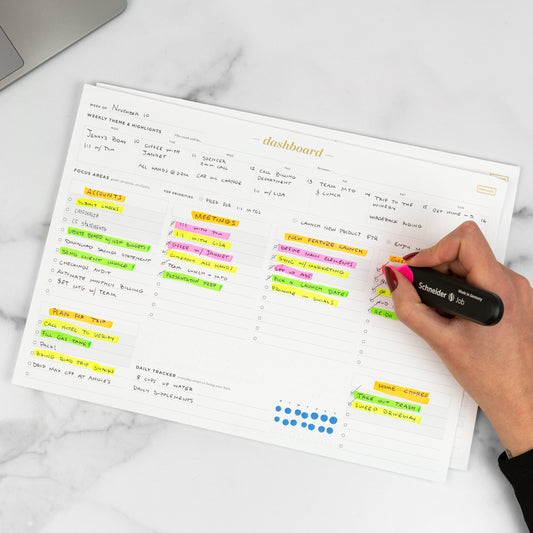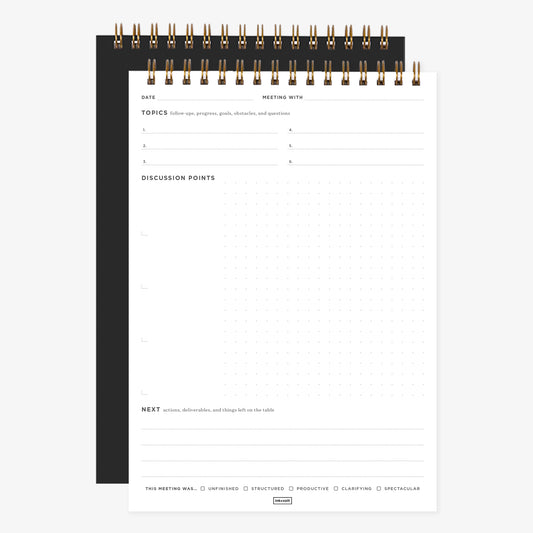If you’re reading this blog, I know you are a person with big plans.
People who have big plans and goals usually have a lot of ideas for how they will achieve their dreams. And while having a lot of ideas is a good thing — it means you’re creative and open to lots of possibilities — it can also be really overwhelming.
Sometimes having too many ideas can even keep you from getting the most basic things done, let alone your big plans and goals.
If you are someone who has a lot of ideas, but who sometimes struggles with putting them into action, then this is the post for you. We’re going to discuss exactly how you can organize your plans, plot them out strategically, and make as many of them happen as possible. (All without forgetting to take care of day-to-day stuff along the way too.)
Write your ideas down
When I feel like I’m overflowing with ideas, a great way to relieve the pressure is simply to write my ideas down. That way I don’t need to fixate on them; they are stored in one place and I can add to them when I have more ideas or new thoughts on existing ideas.
Another benefit of this is you get to see how often your ideas overlap. They can seem totally random in your head, but writing your ideas out can help you see them all together — which gives you an opportunity for seeing similarities and crossover.
This helps you consolidate your ideas, and also see if there are certain areas where you are always having good ideas — because those are usually the places where your real passion and expertise are coming together.
Give your ideas order and weight
Not every idea is equal.
Once you have your ideas written down, try ranking them in order of impact, timeliness, ease of accomplishment…you can choose whatever ranking factors are most important to you or that you think will help you make the best decisions.
If you’re struggling to put them in order, try fleshing your ideas out further. Create a mind map or write a quick list of steps to accomplish each idea, so that you can start to move the idea from the creative stage to the practical stage. Some ideas won’t withstand this process, and others will emerge as achievable and meaningful, which will help you organize them better.
You can also put ideas in different categories, like home, work, relationships, etc. That way you can weight different projects based on their category, and not simply based on every single other idea you have, which can help important-but-not-glamorous projects still get a high ranking within their specific category.
What will have the biggest/most meaningful impact?
This is maybe the most important step in this process. Which of your ideas is actually going to make an impact in your life and/or career, and really move you forward?
Those are the ones you should focus on.
You could also call this step “don’t get distracted by shiny objects”. New ideas are always fun, and it’s easy to get distracted by something that seems easy or fun or likely to result in quick satisfaction.
But you aren’t looking to just do things for the sake of doing them. You want to the work you do to matter; to add up to something; to push you closer to the life you want to live and the person you want to be.
Of course, if you love your ideas, they might all seem really important and impactful in different ways. If that is the case, then look at what your goals are for this year. What is your yearly theme? Where do you want to be by this time next year?
Putting things in this bigger context can help you sort out your ideas in a more objective way.
If you find that none of the ideas that push your towards your yearly goal are really speaking to you, then maybe you need some new ideas or maybe your goal isn’t totally accurate anymore.
Be careful that you’re not just being distracted by the shiniest idea; however, this exercise might reveal to you that what you thought was your big goal is not something you really find meaningful. Maybe you need to look at where your favorite ideas are pointing and redirect your goal that align with them.
Look for synchronicity
Do any of your ideas line up with things your coworkers are working on? Will you be meeting with an influential person from a field matching one of your ideas?
If there’s synchronicity happening, it can mean that now is a great time to put one of your ideas into action. When the ball is already rolling in a direction, it might be because it’s time to just go with the momentum!
Where is your interest pushing you?
Sometimes, an idea just has a hold on you. If you can’t stop thinking about something — even if it doesn’t seem to track with the direction you’ve been going in — that can sometimes outweigh the practical factors and still be worth working on.
Just be careful that you’re not choosing something because it’s easy or flashy. Choose it because it keeps you up at night and you can’t shake the feeling that it could be really important.
Ask yourself why this particular project is speaking to you so strongly. It could be that you’ve found something that will push you in a whole new meaningful direction, in which case, you should probably go for it! Focus on outcomes and align those outcomes with your goals (the things you’ve always wanted). If it’s not a distraction, then it just might be a big opportunity.
Create simple steps and an action plan
If you have big ideas, the thought of getting started can sometimes be overwhelming. If that’s the case, try looking at your big project as a series of really small steps.
Once you know which idea (or ideas) are the best to pursue next, start by plotting out how you will make progress on them. What’s the first thing you need to do? Get super granular — make steps small (like making a phone call or researching something) so that they are easy to add to your weekly schedule and actually accomplish.
Not every idea has to be carried through to the bitter end. If you have a few product ideas, you don’t have to choose only one to pursue; trying to do this can actually just slow you down (if it takes you too long to pick one) or make you discouraged (if the one you pick doesn’t work out).
Instead, make your goal that you will narrow your several product ideas to one great one.
So for example, let’s say you have three ideas for a software tool. Instead trying to guess which one is the right one to pursue, try creating a list of steps that will help you narrow down your ideas to the best one, so that you can then take steps to hone in on making that winning idea happen. You list might look like this:
- Interview potential customers for each product
- Create simple wireframe prototype for each product
- Research existing competitors for each product
Once you feel you know which product idea is most likely to be successful, then you can continue taking steps that will help you pursue that specific idea:
- Take prototype to potential customers for testing
- Create a timeline for building the product
- Get quotes from needed vendors/designers/contractors
Revisit your list of ideas regularly
As you continue to make progress on your ideas, keep checking in on your existing list of ideas. You might just find that you keep coming back to the same area of interest, or that you have new innovative thoughts on old ideas.
By keeping this list alive, you help it be as powerful as it possibly can be.
You are an idea person. Don’t let your ideas overwhelm you; take control of them and harness your creative ideas to do amazing things.









